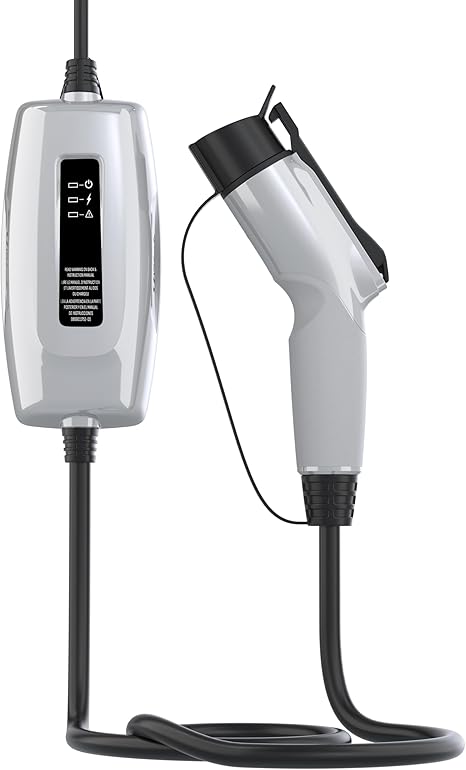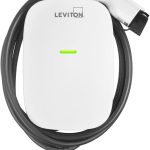A portable Level 2 EV charger is a plug-and-play charging unit that connects to a 240V outlet (like a dryer or range outlet) to deliver much faster charging than a standard 120V Level 1 cord. Level 2 portable units typically supply 16–40 amps (up to 9.6 kW), shortening charge times dramatically. For example, a 16 A Level 2 charger delivers about four times the power of a 120V home outlet, while a 32 A charger can be roughly six times faster. In practice, an EV that needs 24 hours of Level 1 charge could top up in only 6–7 hours on a 32 A Level 2 charger. However, Level 2 charging requires the special 240V outlet and a compatible plug (in North America usually a NEMA 14-50 or 6-20). These portable EVSE units use the SAE J1772 connector (or include adapters) to work with most EVs. (Tesla and newer North American EVs with the NACS port require a special adapter unless the charger is Tesla-specific.)
Portable chargers are prized for mobility and convenience. They can be carried in your car and used wherever there’s a compatible outlet – at home, at work, or when travelingc. This makes them ideal for drivers without a fixed home charger (for example, apartment dwellers or travelers), anyone who drives long daily commutes, and as a backup on road trips. As one EV charging guide notes, portable chargers’ primary advantage is that they “can be carried in the vehicle, allowing you to charge anywhere there is an accessible power outlet”. In short, a portable Level 2 charger gives you fast charging anywhere a 240V plug is available.
Key Features to Consider
-
Amperage (Power Level): Common portable chargers offer 16 A, 32 A, or 40 A. Higher amps mean faster charging (e.g. 40 A ≈9.6 kW). Some units let you adjust the current (often 12–40 A) to match outlet or vehicle limits. Choose at least 32 A (7.6 kW) for full-speed Level 2 charging, but 16 A (3.8 kW) units are more affordable.
-
Connector/Plug Type: In North America, look for NEMA 14-50 or 6-20 plugs. NEMA 14-50 (50A) allows up to 40 A charging, while NEMA 6-20 (20A) limits you to 16 A. Some chargers include dual plugs (5-15 for 120V/Level 1 and 14-50 for 240V) for versatility. Note: These chargers output a J1772 plug, so Tesla or NACS EVs will need a separate adapter (except for Tesla-specific models). International travelers should use appropriate adapters for local outlet standards.
-
Portability: Consider size, weight, and carrying case. Some premium chargers use lightweight aluminum or molded plastic to reduce weight (e.g. J+ Booster 2 is only 7 lbs). Look for a built-in handle or include a storage bag. A fully portable unit should fit easily in a trunk.
-
Cable Length: A longer cable (20–25 ft) offers more flexibility in parking. For example, the Schumacher SC1455 has a 28-foot cord, making it easy to reach a car inlet.
-
Smart Features: Many modern chargers offer WiFi/Bluetooth connectivity and apps. With an app you can schedule charging, monitor progress, or set limits. For instance, Lectron’s WiFi models let you schedule charges and control kWh via a mobile app. If these features matter to you, look for “smart EVSE” on the spec sheet.
-
Weatherproofing: Since portable chargers might be used outdoors, an IP65/IP66 or NEMA 4/6 rating is preferred. Many chargers are built for outdoor use; e.g. JSOWELL and J+ Booster 2 have IP67-rated enclosures, and EVDANCE’s 32 A unit is rated NEMA 4 (IP66) for extreme weather.
-
Safety Certifications: Ensure the charger is UL, ETL or CE certified to meet safety standards. For example, Mustart’s EVSE is UL and CSA certified. In contrast, note that some budget 40 A models (like ShockFlo’s G1) lack any UL/ETL listing – a serious safety concern. A certified charger gives peace of mind (and may be required for insurance or rebates).
-
Warranty and Build Quality: Check the warranty length (1–3 years typical) and reviews of reliability. Durable construction (tough plastic or metal housing, strain-relief plugs) will last longer.
Top Portable Level 2 EV Chargers
Below are several highly regarded portable Level 2 chargers. Each listing includes a brief overview, key features, and pros/cons summary. (Prices and availability may vary by market.)
JSOWLEE 40 Amp Portable EV Charger
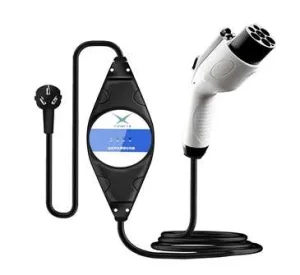
Overview: The JSOWELL is a versatile 2‑in‑1 charger that supports both Level 1 and Level 2 charging. It has selectable current up to 40 A (9.6 kW) and comes with both a NEMA 14-50 and NEMA 5-15 plug (so you can also use it on a 120V outlet at up to 12 A). Importantly, MUSTART’s chargers are UL/CSA certified, and they include a 2-year warranty.
-
Features: 25 ft cable; selectable 16/25/32/40 A; 240V/120V (Dual plug); IP67-rated connector (IP65 controller); WiFi app control (scheduling); LCD screen for real-time status; 2-year warranty.
-
Pros: Very fast charging (up to 40 A) for quick top-offs; durable weatherproof design; smart app scheduling and monitoring; solid safety certification; works in both 120V and 240V outlets.
-
Cons: Bulkier than small 16 A models (though still manageable);price is higher than basic models.
J+ Booster 2 (40 Amp) Portable EV Charger
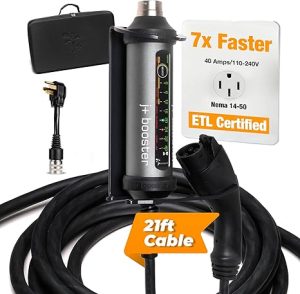
Overview: The J+ Booster 2 is a premium-grade portable EVSE known for durability and power. It offers adjustable current from 12 A up to 40 A and comes with a NEMA 14-50 plug and 21 ft cable. Its housing is made of aircraft‑grade aluminum, and it carries an IP67 rating, meaning it can survive harsh weather and even being run over by a car! Despite that toughness, it weighs only about 7 lbs (with a carrying case).
-
Features: Up to 40 A selectable (12-40 A); NEMA 14-50 plug; 21 ft cord; IP67 waterproof/dustproof; sturdy aluminum alloy body; short-circuit and overcurrent protection; military‑grade cables.
-
Pros: Extremely rugged and waterproof (even 6,600‑lb car crush tested); lightweight for its power; wide amp range for compatibility; very fast charging speeds (9.6 kW at 40 A).
-
Cons: Expensive (a high-end price tag); no WiFi/app features (it’s a “dumb” EVSE); Tesla/NACS vehicles need an adapter to use it; cable is 21 ft (adequate but shorter than some).
ShockFlo Level 1–2 EV Charger (16 Amp)

Overview: The ShockFlo 16 A charger is an affordable portable EVSE that works on either 120V or 240V (with the included NEMA 6-20 plug). It provides Level 1 (3 miles/hour) charging out of the box and up to Level 2 (12 miles/hour at 16 A). It has a simple design with basic LED indicators (no display or smart app). The IP65-rated enclosure means it’s weather-resistant. This unit is often sold for well under $200, making it a budget choice.
-
Features: 16 A fixed current; NEMA 6-20 plug (Level 2) plus adapter for 5-15 (Level 1); 21 ft cord; IP65 waterproof; LED charging indicators.
-
Pros: Very inexpensive; dual-voltage capability (can charge on a household 120V outlet or 240V); simple to use; IP65 weatherproof for outdoor use; lightweight.
-
Cons: Slow 16 A rate (only ~3× faster than Level 1); no display or connectivity; relatively short cord; only basic safety features. Note: ShockFlo also makes a 40 A “G1” model, but that unit is not UL-listed and has known design flaws, so stick with certified models.
Lectron 32 Amp Portable EV Charger
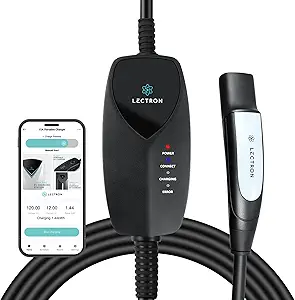
Overview: Lectron’s 32 A portable EVSE is a mid-range option that delivers up to 7.7 kW. It includes a 21 ft J1772 cable and a NEMA 14-50 plug. Lectron offers both a basic unit and a WiFi-enabled version (for app control). The charger has a simple LED status indicator and a push-button for start/stop. It is ETL-listed (UL compliant) and comes with a 1-year warranty. Lectron also sells a specialized Tesla version with dual plugs (5-15 and 14-50) for Tesla owners.
-
Features: 32 A, 240V output; NEMA 14-50 plug; 21 ft cable; LED status lights; weatherproof housing; ETL/UL listed.
-
Pros: Charges about 6× faster than 120V; portable and easy to store; relatively affordable for a 32 A unit; clear LED indicators; well-built.
-
Cons: Only 32 A (some rivals do 40 A); no smart app on basic model (WiFi version requires extra cost); 21 ft cord is on the shorter side compared to others; Tesla/NACS vehicles need a J1772 adapter to use it.
Schumacher SC1455 Level 1–2 Charger (16 Amp)
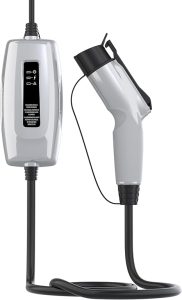
Overview: The Schumacher SC1455 is a well-known portable EV charger that comes with both a 120V adapter and a 240V cable. It offers up to 16 A charging on a 240V (NEMA 6-20) outlet, as well as Level 1 charging via a household plug adapter. What stands out is its very long 28-foot cable, giving extra reach to the EV. The SC1455 is UL-listed and has safety certifications. It’s more expensive than some competitors, but often on sale around $200–$250.
-
Features: 16 A, 240V (3.8 kW max); NEMA 6-20 plug + 5-15 adapter; 28 ft cable; UL-certified; on/off switch; carrying case sometimes included.
-
Pros: Includes both Level 1 and Level 2 charging adapters; very long 28 ft cable; reputable brand with safety listing; straightforward operation.
-
Cons: Slow 16 A max (just ~3× Level 1 speed); larger and heavier than simple portable cords; no app or display; pricier for the performance (but value on sale).
EVDANCE 32 Amp Portable EV Charger
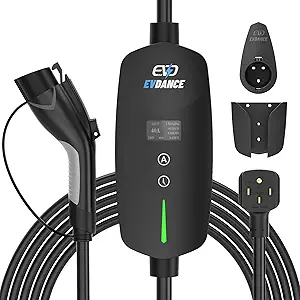
Overview: The EVDANCE portable charger is a robust 32 A (7.7 kW) unit with a waterproof enclosure and heavy-duty cable. It comes with a NEMA 14-50 plug and a 25 ft “military grade” cord that’s extremely durable. The charger boasts an IP66/NEMA 4 rating for all-weather outdoor use (snow, rain, etc.). It includes extensive safety protection (overcurrent, overvoltage, short-circuit, leakage protection, etc.). There is no built-in WiFi, but it is covered by warranty and is ETL listed.
-
Features: 32 A, 240V output (7.68 kW); NEMA 14-50 plug; 25 ft cable; IP66/NEMA 4 weatherproof; heavy-duty drop/fire-resistant cable; built-in protections (GFCI, over-temp, etc.); carry case included.
-
Pros: Very fast charging (up to 6× Level 1 speed); extremely durable and water/dust-tight (operates in –22°F to 122°F); long 25 ft cord; comprehensive safety features.
-
Cons: No smart connectivity or app control; 32 A max (some can do 40 A); somewhat heavy due to rugged build; Tesla users must use an adapter as usual.
Conclusion
Portable Level 2 EV chargers give electric vehicle owners tremendous flexibility and speed. When choosing one, balance your budget with needed features: higher amperage for faster charging, an adequate cord length, and good weatherproofing for outdoor use. Always check that the unit is properly certified (UL/ETL) and compatible with your vehicle’s inlet (J1772 vs. NACS/Tesla). Premium models like the J+ Booster 2 and JSOWELL offer very robust construction and smart features, while budget models like ShockFlo and Schumacher cover basic needs at lower cost. By considering the factors above and consulting real-world reviews, any EV owner – whether living in a city apartment, an RV enthusiast, or a long-distance commuter – can find a portable Level 2 EV charger that fits their needs.

